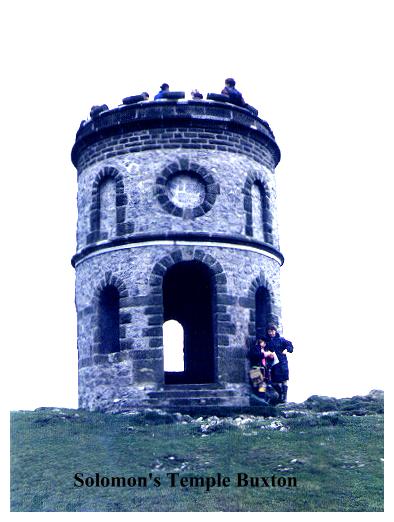13. SOLOMONS TEMPLE
A short and very popular walk on the outskirts of Buxton incorporating mature woodlands, a fine prospect tower and the opportunity to visit Derbyshire's oldest (and possibly finest) show cave. The kids will love it!
Getting There: From centre of Buxton follow the Bakewell Road (A6) to a roundabout by the new supermarket complex. At the roundabout turn right onto Dale Road, following signs for Poole's Cavern. Pass under the railway to traffic lights at Fiveways. Bear left onto Green Lane, passing Buxton College on the right. At Poole's Cavern turn left into the carpark. (Well signposted). Toilets are available by the museum. There is also an adjacent shop.
Distance: One mile approx (very easy)
Map ref: SK 051 726
Rating: Walk * Follies and General Interest ***
Admission to Pooles Cavern (1993) £3.00. Children £1.50. Car parking, country park and museum free.
'Poole-Hole and St. Anne's Well
Makes Darbyshire excell.'
Sir Aston Cokayne 1658
Buxton is a very much a product of its geography. It owes its existence to limestone and warm mineral (chalybeate) springs. The Romans, manically obsessed with health and hygiene as they were, discovered the 'waters' here, built a bath house and dubbed the place Aquae Arnemettae. After their departure the place was more or less forgotten, but in Tudor times it received a considerable boost by the visit of Mary Queen of Scots, who, in the custody of the Earl of Shrewsbury, came to partake of the waters in the hope of easing her rheumatism. Thereafter the place went from strength to strength, becoming even more important in the eighteenth century when John Carr, that famous Yorkshire architect and builder of follies, constructed the Crescent here under the patronage of the Duke of Devonshire, with the intention of mimicking the famous Royal Crescent in Bath (It cost #120,000). Soon after, a riding stables was built here (Now the Devonshire Hospital), with a dome bigger tan St. Peter's in Rome! Alas, though Buxton survived as a spa town, it could never effectively compete with Bath or Harrogate due to its high altitude (it is the highest town of its size in England - standing over 1000 feet above sea level) and the inclemency of its climate. Today Buxton is a town of gardens, bowling greens, limestone rockeries and genteel villas, but its thermal and natural baths are little used.
The walk through Grin Woods to Solomon's Temple is perhaps one of the most popular walks in the Peak District. While there is ample parking, toilets, picnic tables etc., this is not a walk I would recommend for a summer Sunday. It is, alas, a tourist trod - a well beaten track. Nevertheless, if you arrive here when the visitor horde has subsided, the walk to Solomon's Temple is quite a pleasant one, being for the most part a woodland excursion through Buxton Country Park, culminating in fine sweeping views over Buxton. If you are a purist come on a Wednesday in January!
The initial problem on alighting from your car is what to do first - walk up to the folly or visit the nearby cave. The kids will almost certainly opt for the cave, and will need bribing with all manner of goodies if you plan on doing the walk first! Whatever you decide, you would be well advised to take a quick look in the nearby museum-cum-interpretive centre, if only to get a little insight into the nature of the landscape we are now about to explore. As well as the story of Poole's Cavern there are fine displays on prehistory, lime burning, quarrying, minerals and a small video show. Don't worry about delay. This walk is short enough to allow you ample time for all the other attractions.
From the carpark, a well signed path leads up steps into the woods. On reaching a stony track, turn left, following this obvious route up the wooded hillside. These mature woodlands were not always here. The track on which we are walking is an old limers road, and the woods were planted around 1820 by the Duke of Devonshire to hide the enormous eyesore this hillside then presented to Buxton as a result of some two centuries of lime burning. Limestone was cut in the nearby Grin Quarry before being transported to the kilns and burnt into lime, which was used for mortar and for 'sweetening' acid farmland. Limemaking was a wasteful process, and large quantities of waste ash were produced, which was simply tipped on the hillside. The remains of this vanished industry are now obvious to anyone walking here - basin shaped hillocks - lime ash tips, ruins and disturbed ground. Up to the nineteenth century some families even lived inside the ash tips, which formed a hard outer crust that could be hollowed out into living accomodation.
Soon the track reaches a gate at the top of the woods, which gives access to more open country by a small pond. This pond was restored in 1978, and is typical of many such ponds in the area intended to trap surface water. In limestone country, where all rainwater naturally disappears underground, such man-made 'dew ponds' are a vital source of drinking water for grazing stock. From the pond our route bears left through intensively broken ground to the summit of Grin Low where stands Solomon's Temple.

Solomon's Temple, (or Grin Low Tower) is a circular prospect tower with arched windows and a windswept internal staircase which winds up to a viewing platform, from which there is an excellent prospect of Buxton and the surrounding countryside. It was built in 1896 by local farmer Solomon Mycock, as a folly to provide work for the unemployed. Needless to say, it was not the first structure on the site, the earliest being a neolithic burial mound, and the tower is surrounded by the remains of numerous bronze age barrows.
Standing at 1,440 feet above sea level, Solomons' Temple offers views to Mam Tor and Kinder Scout as well as over Buxton, and is, consequently, the ideal spot from which to draw some understanding of the complex hydrology which underlies this rocky, velvety landscape.
Westwards, beyond the busy Leek road, rise the sombre moorlands of Axe Edge, the source of the River Wye, a stream, which in its early stages is elusive to say the least. The streams hereabouts begin their careers on the open moorland, but as soon as they encounter limestone, they promptly disappear underground through a scattering of potholes and swallets. From Solomon's Temple it's easy to see. Across the ways, just below the road stands Stanley Moor Reservoir. Beyond is moorland and running water, while nearer at hand is a landscape of limestone walls and velvet turf pocked with shakeholes and dry gullies. The River Wye has disappeared underground, but we can renew our aquaintance with it further downstream - inside Pooles Cavern.
From the temple our route proceeds without complication back towards Buxton. Pass through a stile in the wall and then descend the rocky hillside, passing round the remains of an old limekiln halfway down. On reaching the next wall, bear left entering Grin Woods through a stile. From here a footpath leads back through the lower part of the woods to the carpark at Pooles Cavern.
And so we finish our short walk at Pooles Cavern. It is, as caves go, one of the more interesting, not only exhibiting, (as caves do) a considerable natural history, but also a fascinating social history. That social history, (although there is a suggestion of prehistoric use), begins with the Romans, who used the first chamber as a shrine. The Romans, as I have mentioned, discovered the thermal waters here, and worshipped goddesses and nymphs that they believed to preside over wells and stygian waters, frequently 'romanising' earlier Celtic deities. Animal bones, coins and jewellery found in the chamber, suggested the Romans made sacrifices and offerings here.
Thereafter the cavern was lost in the mists of time until the middle ages, when it aquired its modern name, derived from an outlaw named Poole who is reputed to have used it as his lair sometime during the fifteenth century. Certainly by the end of the sixteenth century the cavern had become well known, and Mary Queen of Scots is said to have visited it when in Buxton for her rheumatism. Sir Philip Sidney, Ben Jonson, Michael Drayton, Thomas Hobbes and Charles Cotton all waxed lyrical about the cave and its 'wonders', but later commentators were more restrained in their enthusiasm. Defoe, writing in his Tour that he had to crawl on all fours to see something 'ill bestowed with curiosities'.
By the late 18th century, a bunch of 'rapacious old women' acted as guides to the cave, fleecing visitors any way they could, but by 1854, Mr.Frank Redfern, the first regular custodian/guide, had taken up residence outside the cave, which office was held by Mr. Redfern's family until 1954. Access to the cavern was improved and in 1859, a gaspipe was laid into the cave and the whole place illuminated by gaslight, traces of soot from which may still be seen on the cave walls. In victorian times brass bands played both outside and inside the cave, and a monkey house was opened! The 1960's saw a decline and closure of the cavern, its buildings vandalised, and a grim future in prospect, but in 1976 the cavern was purchased by the Buxton Civic Society, Grin Wood was donated by the Duke of Devonshire, and the whole area set to be developed into the popular country park, cavern and interpretive centre of today.
As to the hydrology and geology of Pooles Cavern that is a subject for a booklet in its own right! The cave contains many fascinating formations, the most curious (and unique) being the 'poached egg' (that's what they look like) stalagmites, which are extremely unusual in that while most stalagmites take millenia to form, these are forming in a matter of decades, one of them indeed, growing quite happily on the top of a wooden railing! It has been suggested these formations are caused by leaching from the extensive ash tips above the cave, but just exactly how this process takes place remains in the realms of the obscure. Pooles Cavern is very much all things to all people, but despite the not inconsiderable admission charge it can be an enjoyable end to a pleasant stroll which will leave you with time to explore the 'watering holes' of Buxton, although these days the waters partaken are more likely to be flavoured with hops than sulphur, and sold by the pint!







